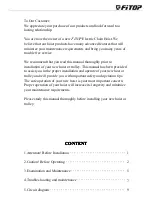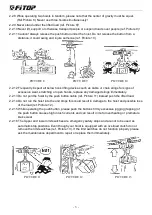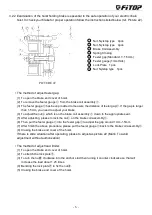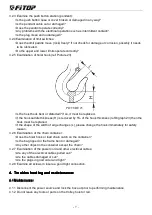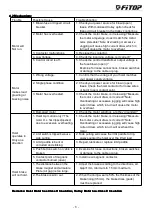
- 2 -
PICTURE 5
PICTURE 4
PICTURE 3
Hook Safety Patch
O
O
O
O
X
X
X
X
PICTURE 7
PICTURE 6
2.
2.
2.
2. Caution!
Caution!
Caution!
Caution! Before
Before
Before
Before Operating:
Operating:
Operating:
Operating:
2.1
2.1
2.1
2.1 Qualified
Qualified
Qualified
Qualified Operator:
Operator:
Operator:
Operator:
2.1.1 Only qualified personnel should be allowed to operate hoisting equipment.
2.1.2 Read this manual thoroughly (ref. Picture 2)
2.2
2.2
2.2
2.2 Correct
Correct
Correct
Correct Operation:
Operation:
Operation:
Operation:
2.2.1 Never exceed the rated capacity of the hoist or trolley
2.2.2 It is required that you clearly mark the capacity of the hoist on the monorail or bridge beam
(ref. Picture 3) for the operator's reference.
2.2.3 Use this and all hoisting equipment in a safe and proper manner. Improper or negligent use of this
equipment could result in bodily injury or death to the operator or surrounding personnel
(ref. Picture 4).
2.2.4 Do not remove the safety latch from the top or bottom hooks. The safety latch is designed to
secure the hook to the lifted load. It can prevent the load from slipping off the hook (ref. Picture 5).
Furthermore, local and national safety laws require all hoists to be equipped with safety latches.
2.2.5 Always center the hoist over the load to be lifted. Attempting to lift loads off center can result in
damage to the hoist or injury to the operator.
2.2.6 Before lifting a load examine it to insure that it is rigged properly and that it will not spill or topple
over causing damage or injury (ref. Picture 6).
2.2.7 Make sure the load to be lifted is free of any attachments such as chains, bindings or clamps.
While lifting the load (ref. Picture 7) take care that it does not snag or catch on stationary objects.
PICTURE 2


